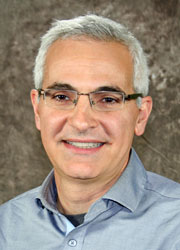
Ph.D. 1997 - University of Notre Dame
Postdoc. 1998-2005 - University of Washington (Stanley Fields)
Not Accepting Students
Publication Listings
The research philosophy of the Hazbun lab is to approach biological questions from a network perspective and also utilize traditional scientific reductionist approaches to dissect and understand biological phenomena and mechanisms. Our research program uses systemwide approaches in yeast to investigate biological pathways involved in mitosis and cellular homeostasis related to human disease. We also use chemogenomic profiling to identify antifungal targets and characterize fungal gut metabolomics. In addition to these approaches we also use conventional biochemical, genetic and biophysical approaches to validate and interrogate the cellular network nodes and connections.
The lab currently has three major areas of research:
• Functional investigation of the N-terminal methyltransferome
• Chemogenomic profiling of small molecules and identification of antifungal targets
• Metabolomics of the gut fungal mycobiome
Significance of N-terminal methylation
• N-terminal methyltransferase (NRMT1 and NRMT2) mutations are found in cancers including endometrial, lung and breast cancer
• NTMT1 is overexpressed in several cancers in at least colorectal adenocarcinoma and malignant melanoma
• Loss of methylation of substrate proteins results in genome stability and impaired DNA repair pathways eg.RCC1, a regulator of chromatin condensation and DDB2, a DNA repair protein
• Biological knowledge is very narrow and we need a global picture to aid in selective targeting of this pathway for therapeutic applications
Why investigate N-terminal methylation in yeast?
- An opportunity to define the N-terminal methylome of all 45 potential substrates
- Systemwide approaches and resource are readily available
- Genetically and biochemically facile organism for mechanistic investigations
- Highly conserved enzyme mechanism and recognition motif
Chemogenomic Profiling
• Haploinsufficiency (HIP): identification of direct targets - gene dosage in each strain is at 50% and further small molecule inhibition of the reduced gene product results in preferential sensitivity
• Homozygous deletion profiling (HOP): identification of buffering pathways based on sensitivity or resistance of these homozygous deletion strains.
Targets Identified by Hazbun lab using Chemogenomics
- Ebselen – glutathione and ROS production
- Auranofin – Mia40 mitochondrial disulfide relay substrate folding
- Novel dibromoquinoline – metal ion homeostasis
- Symmetrical molecule with a bisphenol A core – Hsp90 inhibitor
- Mitosis and Cancer
- Chromosome segregation
- Aurora kinases
- Chaperone biology
- Hsp90
- Hsp31
- Chemogenomics identification of antifungal compounds
- MCMP 422 - Immunology
- PHRM 825 Professional Program Laboratory II Antibody-based diagnostic tests
Positions and Employment
1998-2005 Howard Hughes Medical Institute, Postdoctoral Associate, University of Washington
2001-2005 Two-hybrid Screening Coordinator, Yeast Resource Center (NCRR), University of Washington
2005-2011 Assistant Professor of Medicinal Chemistry and Molecular Pharmacology, Purdue University
2005-present Full Member of the Bindley Bioscience Center, Discovery Park, Purdue University
2011-present Associate Professor of Medicinal Chemistry and Molecular Pharmacology, Purdue University
Other Experience and Professional Memberships
1994-1997 Teaching Assistant, Department of Biology, University of Notre Dame
2003 Future Faculty Fellows program, HHMI sponsored workshop
2005-present Instructor – Immunology for Pharm.D. students
2005-present Instructor – Cell Cycle and Drug Discovery for Graduate Students
Professional memberships Genetics Society of America, ABMB
Ad hoc reviewing activities
Reviewed for Nature Biotechnology, Biochemistry, PNAS, PLoS Genetics, PLoS Pathogens, PLoS One, Protein Science, Genome Biology, Cold Spring Harbor Laboratories Protocol, Biotechniques, Bioinformatics, Assay Development and Technologies, Genes Genomes and Genetics (G3), Methods, Wiley Encyclopedia of Chemical Biology.
Reviewed grants for:
National Institute of Health (NIH) – Genomics, Computational Biology and Technology Study Section
National Science Foundation (NSF)
Biomedical Research Council A*STAR – Singapore
Civilian Research and Development Foundation (CRDF)
New Zealand Ministry of Science and Innovation (MSI)
Faculty Chair for Computational Interdisciplinary Graduate Program 2017-2022
PULSe Computational and Systems Biology Training Group Chair 2018-2021
MCMP Graduate Admissions Committee Chair 2015-current
Chen, Panyue, Rong Huang, and Tony R. Hazbun. "Unlocking the Mysteries of Alpha-N-Terminal Methylation and its Diverse Regulatory Functions." Journal of Biological Chemistry (2023): 104843.
Thangamani, Shankar, Ross Monasky, Jung Keun Lee, Vijay Antharam, Harm HogenEsch, Tony R. Hazbun, Yan Jin, Haiwei Gu, and Grace L. Guo. "Bile Acid Regulates the Colonization and Dissemination of Candida albicans from the Gastrointestinal Tract by Controlling Host Defense System and Microbiota." Journal of Fungi 7, no. 12 (2021): 1030.
Chen, Panyue, Tiago Jose Paschoal Sobreira, Mark C. Hall, and Tony R. Hazbun. "Discovering the N-terminal methylome by repurposing of proteomic datasets." Journal of Proteome Research 20, no. 9 (2021): 4231-4247.
Eldesouky, Hassan E., Ehab A. Salama, Nadia A. Lanman, Tony R. Hazbun, and Mohamed N. Seleem. "Potent synergistic interactions between lopinavir and azole antifungal drugs against emerging multidrug-resistant Candida auris." Antimicrobial agents and chemotherapy 65, no. 1 (2020): e00684-20.
Eldesouky, Hassan E., Nadia A. Lanman, Tony R. Hazbun, and Mohamed N. Seleem. "Aprepitant, an antiemetic agent, interferes with metal ion homeostasis of Candida auris and displays potent synergistic interactions with azole drugs." Virulence 11, no. 1 (2020): 1466-1481.
Guinan, Jack, Shaohua Wang, Tony R. Hazbun, Hariom Yadav, and Shankar Thangamani. "Antibiotic-induced decreases in the levels of microbial-derived short-chain fatty acids correlate with increased gastrointestinal colonization of Candida albicans." Scientific reports 9, no. 1 (2019): 8872.

